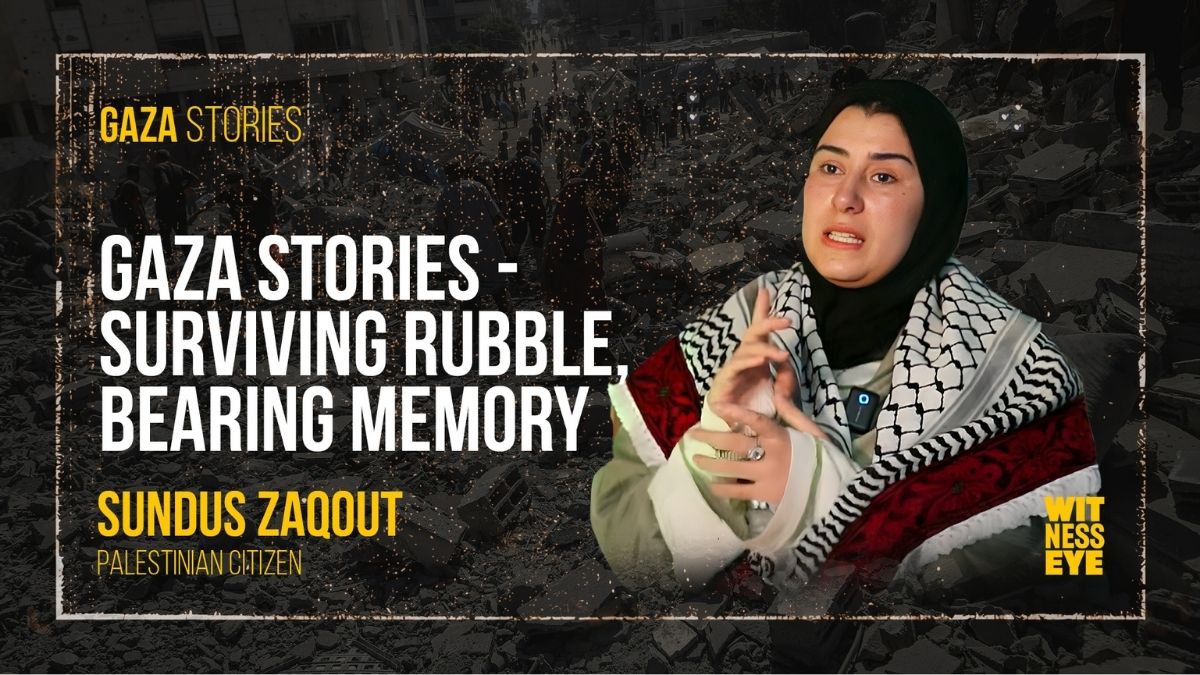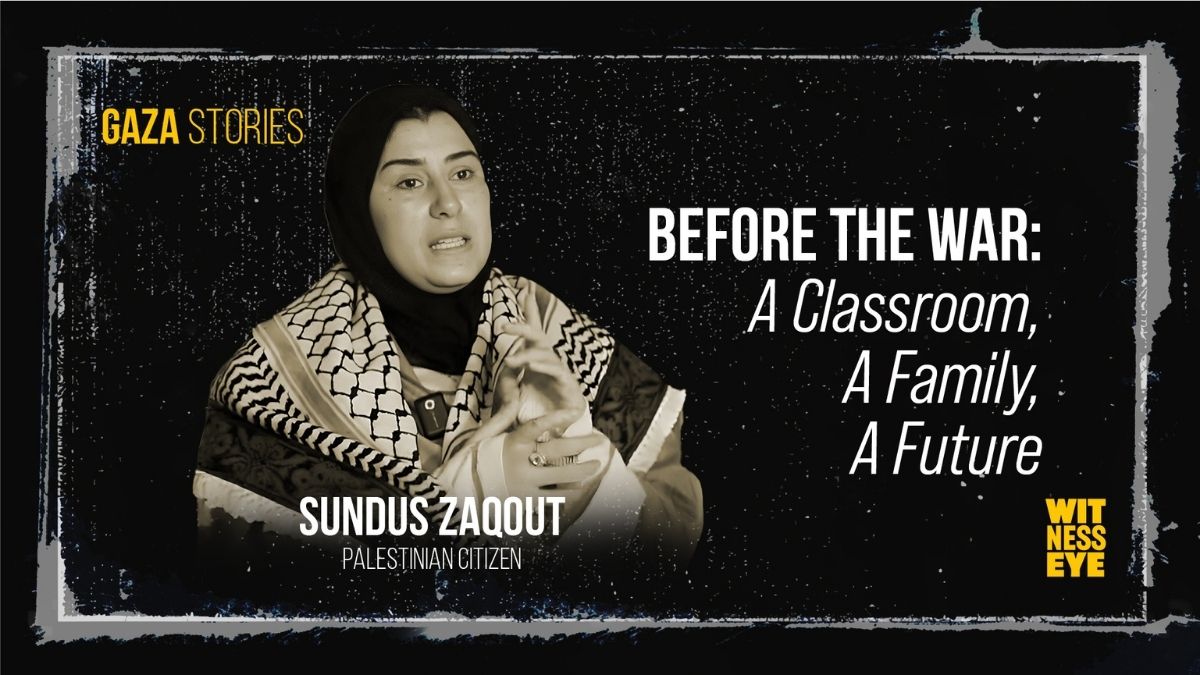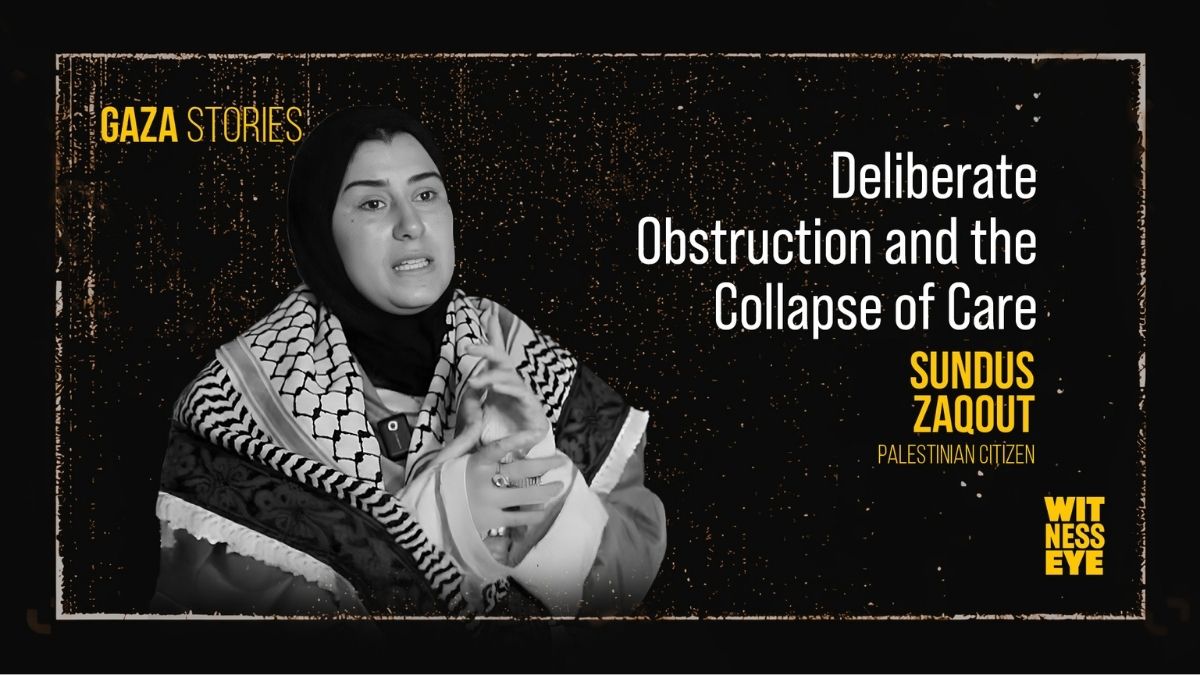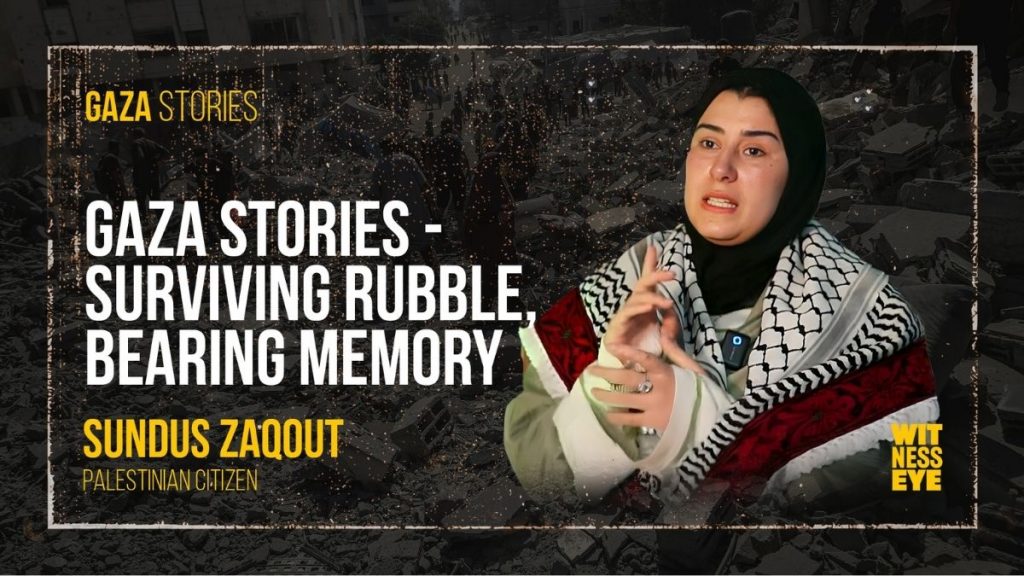
Sundus Zaqout on Survival, Loss, and the Work of Memory… When Gaza Stories are told, the first images are often ruins and statistics. But sometimes a single voice lifts above the dust. “I woke up under the rubble thinking I was dreaming,” says 27-year-old Sundus Issam Atiya Zaqout. In that suspended moment—between sleep and the weight of four collapsing floors—her life split into before and after. What follows is her testimony of survival, of a family erased in seconds, and of what it means to keep living when the future has been shrunk to the next hospital corridor. This account joins the ongoing archive of Gaza Stories, a series bearing witness to civilians targeted, displaced, and left to rebuild from absence.

Before the War: A Classroom, A Family, A Future
Before October 7, Sundus’s days were defined by work and ordinary ambition. “My name is Sundus Issam Atiya Zaqout, I am 27 years old. I graduated from Al-Aqsa University with a degree in English Education,” she begins. She taught English, translated, coordinated projects—“many things,” she says, because in Gaza one learns to be many people at once. There was a home. There was a family. “Life was very beautiful in Gaza,” she remembers. That beauty is part of Gaza Stories too: mornings that tasted like routine, school bells, siblings, and the warm architecture of a life not yet interrupted.
The Night of the Massacre
The family’s displacement began in the early days of the war, from the Beach Camp in the north to relatives’ homes in the south. During a brief ceasefire, they decided to visit kin. “We said we would go to my uncle’s house,” she recalls. Her uncle worked with UNRWA. “We all thought we were sleeping safely.” At 9:30 p.m., her toddler nephew woke crying. “My mother was dizzy so she told me to just bring his bottle. I went to the sink. The last thing I remember is grabbing the bottle.”
Then—collapse. “I woke up under the rubble thinking I was dreaming… I actually wanted to continue sleeping,” she says. Four floors lay over her. Somewhere above, a belt of fire sealed the street. “They created a continuous fire belt for five minutes on the entire street… We were an entire block of four houses. They wiped them out at the same time.” The scale of loss staggers language; Gaza Stories often do.
That night, 13 members of her extended family were killed—her parents, her younger sister, two children of another sister, and several cousins and uncles. “I was basically the only survivor,” she says. Her uncle, who had slept in the stairwell, survived by accident and emerged to discover his home was the target. He had assumed a mosque across the street had been struck. It is a pattern documented across the Civilian Impact Reports and Civilian Casualty Mapping projects: houses reduced at once, families taken in clusters, the private space of safety turned into a site of public mourning.
Gaza Stories – From Shrapnel to Amputation
“The boy woke up crying… I grabbed the bottle… then I don’t remember anything.” A small piece of shrapnel in her big toe led to gangrene. “They told me I had two options: either amputate my leg or leave it to continue spreading and I would die.” She chose life: “My mother came to me in my head and told me, no, amputate it… It was as if my mother was alive and present with me.” Her leg was amputated on December 11, 2023—nine days after the injury. In those days she still believed, because people told her so to keep her alive, that her parents had survived. Only 25 days later did she learn they were gone.
The decision to amputate is both medical and existential. “At that moment, you don’t have time to think,” she explains. The calculus is brutal: a limb or a life, a foot or a future. In Gaza Stories, the body becomes a ledger of choices forced by infrastructure collapse and deliberate obstruction—surgeries delayed, referrals stalled, roads turned to risks.
A Delayed Evacuation, A Lost Vision
Her eye was another triage. “They saved the eye,” doctors told her, “but if you leave within a week, you’ll be able to see with it again. If you don’t leave within a week, you’ll lose your vision completely.” Evacuation took a month and a half. She reached Turkey to news no doctor wants to pronounce: “You’ve lost vision in that eye completely.” She taps gently, almost apologetically: “By the way, this eye is a prosthetic.”
On the attempt to transfer her between hospitals inside Gaza, she adds a detail that should appear in every index of War Crimes Documentation: “Two ambulances left. The first ambulance was bombed, everyone in it was martyred. The driver of our ambulance immediately turned back. He refused to continue.” That turn saved her life—and cost the lives of people meters ahead. Gaza Stories carry this math of survival, measured in seconds and corners.

Deliberate Obstruction and the Collapse of Care
Sundus describes Al-Aqsa Martyrs Hospital being forced to evacuate: “Approximately in one ambulance, they would evacuate ten injured people… The companions who were with the patients were hanging on the doors.” She was in the last ambulance to leave. “Two minutes later, Al-Aqsa Hospital was bombed.” The image is stark: a line of stretchers and the rumor of a moving roof, carried by vehicles too full to be safe. For those building the Digital Evidence Archiveand the Genocide Evidence Files, such testimony marks patterns—targeting of medical infrastructure, denial of evacuation routes, and cascading harm from delayed treatment—relevant to International Humanitarian Law and Crimes Against Humanity.
For broader legal context and precedent mapping, see our coverage of the Gaza Tribunal’s First Public Session in Bosnia and the ongoing Gaza Tribunal Reports. These proceedings, together with Forensic Investigationsand Military Conduct Analysis, form a scaffolding for international justice efforts that may one day hold perpetrators to account.
Life Away From Home: Seven Months in a Hospital Room
Sundus eventually reached Ankara. “I stayed in Bilkent Hospital until June… seven months.” The hospital became a geography of its own: operating rooms, a prosthetic eye, a leg gone, a hand rebuilt with bone grafts, both eardrums perforated. “About every two weeks, I need hospital,” she says. Then, a fragile normal: a rented apartment, a bed where anxiety still sits upright. “If we hear news of bombing in a certain place, we don’t sleep that night. Because you think, it’s the only one I have left—what’s left might go.” In Gaza Stories, the war keeps time even outside Gaza.
Her “healthy” leg carries permanent platinum from pelvis to knee. “My amputated leg is much better than my ‘healthy’ leg. I can’t stand on it,” she says with a wryness that doesn’t ask for pity. Her face, once holding nine pieces of shrapnel, has healed enough that “no one would believe” they were there. The mirror tells one story; muscle memory tells another.

The Children in Tents: Starvation, Disease, and a Stolen Education
Meanwhile, her brother and his family live in a tent. “Our house in the Beach Camp is gone. My brother’s home in Juhor al-Dik is gone.” The entire building—“like a biscuit”—crumbled to dust. “Every week, one of [the children] gets sick,” she says, listing pollution, lack of clean water, and infested flour. She describes a toddler’s first banana in months: “She ate it with its peel… She had never seen fruits.” The banal cruelty of deprivation bends childhood into unfamiliar shapes.
Education is the loss that shadows the rest. “Our weapon in Gaza is education,” she insists. But there are no classrooms, no books, no electricity. Her words echo through our Stories of Survival series and align with prior reporting such as Gaza’s Missing: Thousands Lost in the Shadow of War and Gaza Stories: A Mother’s Last Words — A Family’s Goodbye, where families weigh lessons against hunger and choose fuel over light. This is not collateral; this is the field where human rights violations in Gaza grow into generational damage.
Systematic Targeting: Women, Children, Civilians
“Do you feel that this war is systematic in targeting children, women, civilians?” we ask. “Of course,” she answers, then counts. In her family’s massacre: seven women, four children, two men. She references days when “from 160 to 180 children” were killed in a single day. Whether one doubts exact tallies, the throughline of Gaza war crimes remains constant across testimonies and evidence—social media evidence cataloged, eyewitness testimonies compiled, and legal accountability cases advanced.
For readers building their own research paths, explore our Accountability Watchlist and Gaza Tribunal Evidencehub, where civilian accounts intersect with International Humanitarian Law frameworks and Forensic Investigations outputs.
“Where Do I See Myself? In the Hospital in a Month.”
The future, for Sundus, is measured in follow-ups. “Where do I see myself? In the hospital in a month,” she says, half-smiling. The sentence lands with the weight of Gaza Stories everywhere—resilience tempered by bureaucracy and pain management, by the necessary chores of survival. She speaks of dreams where her parents visit: “We’re not used to seeing you like this.” The injunction is not to be cheerful but to be steadfast. “I see myself needing to stand up. I need to make my parents proud,” she says.
There is an argument buried inside her hope: that testimony is not only grief but governance. By speaking, she adds her name to a ledger that Witness Eye shares with lawyers, analysts, and the public. It is a ledger expanded by Gaza Justice efforts and informed by the Gaza legal review process. It folds into the Digital Evidence Archive, alongside voices like those featured in Gaza Justice: Voices of Justice and Grief from Gaza and the field reports captured in Gaza Stories: Hossam’s Fight to Witness and A Test for Humanity — When Law Collapses.

What the Law Must See
Her testimony underscores three legally salient points:
-
Direct targeting of civilians and homes — “We were an entire block of four houses… They wiped them out at the same time.” This aligns with patterns examined in Destruction of Civilian Infrastructure and Gaza War reporting.
-
Obstruction of medical evacuation and care — ambulances targeted, hospital evacuations under fire, transfer delays that turned a salvageable eye into permanent blindness. These elements feed into the Gaza Tribunal Reports and broader international justice efforts.
-
Systematic impact on protected groups — women and children disproportionately killed, education extinguished, starvation used as a weapon—documented across War Crimes Documentation and Human Rights Violations Gaza.
Each point is strengthened by cross-referencing survivor accounts with Forensic Investigations and Military Conduct Analysis. Where possible, Expert Witness Gaza testimony corroborates timelines and intent, ensuring that the archive speaks with both compassion and precision.
Gaza Stories – The Weight of After, The Work of Now
Late in the interview, Sundus returns to prayer as a grammar for endurance. “Maybe God is hiding a great reward for you,” she tells herself, finding calm in patience. Yet her calm is not quietism; it is the steady, public labor of telling the story again. Gaza Stories are not a genre but a duty—toward memory, toward international humanitarian law, toward the children eating peels because they have not seen fruit in months.
For readers new to this series, start with the Gaza Stories category and then trace the jurisprudence arc through the Gaza Tribunal category. Recent contextual reporting can be found in News. For parallel narratives of loss and resistance, see Lost Over 90 Family Member — Story of Dr. Rinad Al-Majdalawi and Gaza Stories: Final Words — Between Grief and Duty. These pieces, together with Sundus’s testimony, expand the Accountability Watchlist and enrich the record upon which future verdicts may rest.
Now, hear the testimony of Sundus Zaqout in her own words—survivor, witness, and keeper of memory—carrying Gaza’s grief, loss, and unyielding call for justice into the record of history.
Published By Besa Witness Eye
Stay Connected with Witness Eye
Follow us on our official channels:
